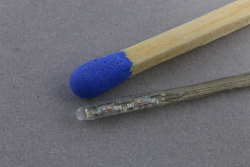New device allows people with hearing loss to hear with light pulses
Nearly 70 million adults in Europe suffer from hearing loss greatly enough to negatively affect their quality of life, and numbers are expected to reach about 90 million by 2025. Cochlear implants, which are surgically implanted devices, have already proved that they can transform the daily lives of hearing-impaired patients. Conventional cochlear implants transmit a signal to an array of electrodes placed in the cochlea, which in turn electrically stimulate the cochlear nerve causing it to send signals to the brain. Electrical stimulation is, however, limited in many aspects, mainly because the cochlear shape limits the options of narrowly focusing the electric field in the desired region. With EU funding, the project ACTION (Active implant for optoacoustic natural sound enhancement) overcame challenges associated with spatial constraints related to cochlear implants based on electric stimulation. Researchers developed an optoacoustic single-channel device that has the potential to free up the outer ear and offer patients a greater degree of freedom. Listening with light ACTION built on the discovery that pulsed infrared laser light is capable of triggering auditor activity in hair cells. ‘The project relies on the use of laser light to create a sound wave in the fluid of the cochlea,’ explains project coordinator Mark Fretz. ‘Unlike conventional implants which use electric currents, optoacoustic stimulation relies on functional hair cells to convert sound waves to electric signal.’ Laser light is used to produce a sound wave travelling in the cochlea fluid that moves the tiny hair cells. In response, these generate an electric signal travelling along the auditory nerve to the brain where it is perceived as sound. The device used as a light source for optical stimulation is a vertical cavity surface emitting laser (VCSEL) with optimised wall plug efficiency in the infrared part of the spectrum. Given that high-intensity light is more likely to generate an audible sound in the cochlea fluid, project partners designed a new ultra-thin lens made of silicon to collimate the VCSEL light. The VCSEL was hermetically sealed inside a biocompatible sapphire box to protect it from bodily fluids and prevent any toxic materials affecting the body. ACTION selected sapphire due to it being biostable, biocompatible, and with very low permeation with regard to water vapour as well as the optical transparency necessary for the device. Project partners also worked on the development of a biocompatible flexible substrate that accommodates the metal lines needed to connect the VCSEL to the power supply. Specially designed antifouling coatings can impede growth of body tissue on the sapphire package. Adhered body tissue absorbs the VCSEL light and thus reduces device efficiency. Optimising functionality The newly developed miniaturised device has the size of an average laptop adaptor. The next-generation device will be capable of measuring the optoacoustically generated compound action potentials (CAPs). ‘This is the first time that use of a light source fully inserted into the unmodified cochlea can trigger the generation of a CAP,’ explains Mr Fretz . ‘Until now, CAPs in the cochlea could only be achieved with external light sources connected to a fibre optic light guide or with optogenetically modified cells.’ Until the implementation of such systems, there are a number of challenges that need to be overcome. These include further miniaturisation of the sapphire package to be inserted further in the cochlea. In addition, the device’s power consumption has to be reduced by at least a factor of two to achieve an acceptable operation time before battery recharge. ACTION’s new device requires the presence of the hair cells in the cochlea. Patients who lack functioning hair cells in a certain region may in the future benefit from the use of a conventional cochlear implant and a laser-based one integrated in a single device.
Keywords
Deaf, cochlear implants, ACTION, optoacoustic, sound enhancement, laser light

